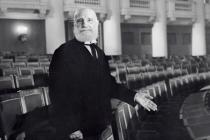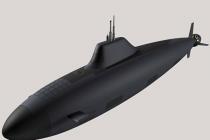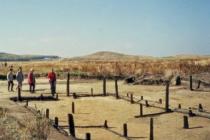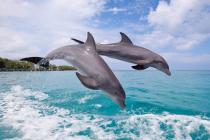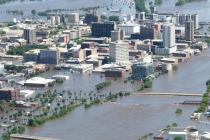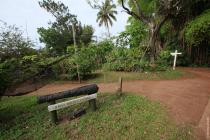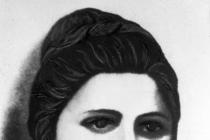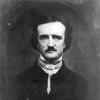ALL PHOTOS
Five of the seven men accused of sex crimes on Pitcairn Island have been found guilty. Among them is the 53-year-old mayor Steve Christian - he was found guilty of five rapes of girls, including 12-year-olds. His son Randy Christian was convicted of four rapes and four sexual assaults.
The oldest defendant in the Len Brown case is charged with two rapes, while his son, Dave Brown, was convicted of nine sexual assaults. Dennis Christian pleaded guilty to three attacks in court. Jay Warren was the only person found not guilty of all charges.
The Pitcairn Island rapists will be sentenced this week, The Australian reports. However, all the accused will remain at large at least until the New Year.
Seven men, among the 47 residents of the tiny British island located on the route between New Zealand and South America, faced a total of 55 counts of charges.
It all started when Simon Moore, Pitcairn's prosecutor based in Oakland, circulated a statement through Wellington's British High Commission in April 2003, stating that seven islanders had been indicted in court in Adamstown. The statement contains charges of "insulting a person's sexual nature."
As follows from the materials of the investigation, it was about sexual violence and sexual abuse in a particularly perverse form, committed by the accused back in 1999. According to preliminary findings, the criminal episodes include the rape of seven-year-old girls, including the sexual assault on a three-year-old child.
Pitcairn Island is home to the descendants of the rebels who landed here by the British warship Bounty in 1790, and the Polynesians.
Pitcairn is administratively subordinate to the British government in Auckland, located approximately 5300 km from the island. In 1936, up to 200 people lived on Pitcairn, but every year the number of residents decreases, as people leave for work or study in New Zealand and never return.
Currently, 47 people live on the island. Pitcairn, which is only 3 km long and 1.5 km wide, has no airport, hotel or prison. All criminals are serving their sentences in New Zealand.
The island became a British colony in 1838. The British High Commissioner for New Zealand is currently the Governor of Pitcairn. The island has a local self-government body - the Island Council, which consists of a magistrate, 5 members elected annually, 3 members appointed for one year by the governor, and a secretary of the island.
World Map MapSeptember 08-10, 2011
The length of the historical introduction to this state is inversely proportional to its size.
The length of the historical preface to this state is inversely proportional to its size.
It all began in 1787, when the British government sent an expedition to Tahiti for breadfruit seedlings. The idea was to bring breadfruit as cheap food for slaves in the Caribbean, where there were many slaves and little cheap food. The British Navy acquired the ship, renamed it the Bounty, put Captain William Bligh in charge and sent it on a mission.
It all began in 1787, when the British government dispatched an expedition to Tahiti to collect some breadfruit tree saplings. The idea was to transplant the breadfruit tree to the Caribbean, where it could be used as a cheap source of food for slaves — since there were a lot of slaves there and not a lot of cheap food. The Royal Navy bought a ship, renamed it to Bounty, appointed William Bligh as captain and sent it on its mission.

Bly sailed through Tierra del Fuego, but there were such storms (my glasses were blown off in the sea in Chile) that after a month of torment he decided to reach his goal from the other side - through what is now called the Southern Ocean. They sailed to Tahiti, but the crew was so tired that the ship stood there for six months. During this time, the crew managed not only to load the breadfruit, but also to make friends with local girls. It was hard to swim away. But business is business. They swam.
Bligh set course past Tierra del Fuego, but the storms there were so bad (I even had my glasses blown off into the sea in Chile) that, after a month of torture, he decided to try and sail to his destination from the opposite side —Through what is now known as the Southern Ocean. They made it to Tahiti, but by then the crew was so tired that they stayed put for six months. In that time, the ship's company managed to not only collect the breadfruit saplings, but to make friends with the local ladies as well. It was hard to leave. But there was business to attend to, so they set sail.

They departed quite a bit, as the captain's mate - Fletcher Christian - started a riot. Bloodless, but quite real. Captain Bly and his men were put into a boat, given quite a bit of water and provisions with them, and sent to all four directions. Bly was doomed.
They hadn’t gotten very far when mutiny— instigated by the master’s mate, Fletcher Christian — broke out on the ship. The mutiny was bloodless but still no joke. Captain Bligh and his loyal followers were set adrift in a small launch with a bare minimum of water and provisions. Bligh was doomed.

And Christian himself on the Bounty with the rest of the people sailed back to Tahiti. The rebels thought dreamily of the girls. They sailed back, found their girls and began to get high again. But Christian understood that sooner or later the punishing sword of British justice would find out everything and it would not be good. So he decided to dump somewhere. Seven more crew members went with him. Each took a Polynesian girl. They also took six natives as slaves, for which three more girls were captured.
Christian and the remaining sailors on the Bounty sailed back to Tahiti. The mutineers dreamed wistfully of the Tahitian women. They made it back, found their ladies, and resumed having a good time. But Christian knew that sooner or later the vengeful sword of British justice would catch up with them, and then they’d really be in for it. So he decided it was time to split. Seven more of the crew members joined him. Each took along a Polynesian woman. They also brought six natives as slaves and three more women for them, too.

Looking ahead, we will say that those who remained in Tahiti were taken after some time to England, where everyone was tried, and some were even executed. And Fletcher went in search of the deserted Pitcairn Island marked on the maps. The island was discovered shortly before the aforementioned events and is named after the sailor who first saw it. But the island was marked with an error of two hundred miles on the maps, so we had to swim around until we found it. It was 1790th year.
Jumping ahead, I can tell you that the sailors who stayed on Tahiti were eventually taken back to England, where they were all tried and some even executed. Fletcher, meanwhile, went to seek the uninhabited island of Pitcairn, which he saw marked on the map. The island had been discovered not long before the events in question and was named after the sailor who first spotted it. But the location indicated on the map was 200 miles off, so it was a while before they found it. The year was 1790.

Our rebels began to live, live, and make good money. We learned how to drive alcohol, so it was fun. The island was divided among themselves by the British, leaving nothing to their Polynesian friends. Everything of value was removed from the ship, and the skeleton was burned.
Our mutineers began to live happily ever after. They figured out how to distill alcohol, so good times were had by all. The island was divided up by the Englishmen, who left nothing for their Polynesian friends. The ship was stripped of everything valuable and then burned.

So everything went on, until one fine moment the wife of one of the Englishmen fell off a cliff while collecting bird eggs (according to legend). The peasant grieved a little, and went to take the woman away from the six Polynesians. Recall that the natives had three women for six. The natives were not at all happy with this arrangement. And they decided to dunk the whites. Half were soaked (including Fletcher). The remaining half soaked all the Polynesians. As a result of the natural decline from drunkenness and stabbing, a lot of women remained on the island, even more children were born by that time and one and only man - John Adams.
And so they lived until, one fine day, the wife of one of the Englishmen fell of a cliff while collecting birds' eggs (or so the story goes). The guy grieved for a little while and then went to take one of the chicks away from the six Polynesians. Let me remind you that the aborigines had three chicks to share among six dudes as it was. Hardly pleased with this turn of events, they decided to bump off all the white guys. They succeeded in killing half of them (including Fletcher); the remaining half killed all the Polynesians. As a result of natural attrition due to drinking and knife-fights, there eventually remained a bunch of women, even more children (since a fair number had been born by that point) and one single dude — John Adams.

Then came the moment of enlightenment. The Bible came to the rescue. Adams somehow began to read it, was imbued with and began to raise women and children. There was neatness and order.
And then came the moment of enlightenment. The Scriptures played a part: Adams somehow started reading the Bible, got into it and began to educate the women and children. Righteousness and order ensued.

Thirty-five years after these events, a British ship sailed by. With surprise, the captain listened to the story of a gray-haired old man surrounded by a village of swarthy people. Adams received a pardon from the crown.
Thirty-five years later, a British ship happened to be sailing past the island. Its captain listened with much astonishment to the story told by the gray-bearded old man who stood surrounded by a crowd of swarthy villagers. Adams was granted amnesty by the Crown.
Two hundred years have passed. There were all kinds of things. At some point, all residents were moved to Norfolk Island, for a couple of years the island was completely deserted. But some of the families came back. And today the direct descendants of the rebels from the "Bounty", diluted with Polynesian blood, still live here.
Two hundred years have since gone by. All sorts of stuff happened in that time. At one point all of Pitcairn’s residents were resettled to the Norfolk Island and Pitcairn stood completely uninhabited for a couple of years. But some of the families came back. And today the island is still populated by direct descendants of the Bounty mutineers, with some Polynesian blood mixed in.

It is impossible to approach the island on a large ship. All goods and people are transported on longboats, which are stored in the garage.
It’s impossible to get close to the island on a large ship. All cargo and passengers are brought over on launches, which are stored in a garage.

The ocean is always restless here.
The ocean is always choppy here.

Until recently, wooden boats were made directly on the island, but today they have been replaced by aluminum ones. The latest local model from 1980 stands as a museum piece.
Until recently, wooden boats were manufactured right here on the island, but today they’ve been replaced with aluminum ones. The last local model, made in 1980, stands on the shore like a museum piece.

The longboat sails to the anchored ship. On it are several able-bodied men and a police woman.
The launch approaches the anchored ship. Aboard it are several able-bodied men and a policewoman.

Stamp in the passport, moving to the island. About 50 people live here.
A stamp in the passport — and onto to the island. About 50 people live here.

There are no hotels on Pitcairn. Betty and Tom Christians accept me. He is, for some time, the great-grandson of the Christian who staged the mutiny. Betty shows the island.
There are no hotels on Pitcairn. My gracious hosts are Betty and Tom Christian. Tom is the many-times-great-grandson of the very Christian who started the mutiny. Betty shows me around the island.

Her responsibilities also include monitoring the weather station and transmitting parameters to New Zealand. Betty takes a statement.
Her responsibilities also include monitoring the weather station and reporting the data to New Zealand. Betty takes a reading.

She also changes the card every day in the heliograph (a special device for observing the sunshine). A sunbeam, if not obscured by clouds, passes through a glass ball and burns out a hole. The result is a clear picture of solar activity during the day. The calculated sundials are then transmitted to the New Zealand hydrometeorological center.
Every day, she also replaces the card in the sunshine recorder (a special device for measuring the amount of sunlight). When the sun is not obscured by clouds, its rays pass through the glass orb and burn a hole in the card. The result is a visual record of the sun's activity throughout the day. The sun hours are added up and then reported to the New Zealand MetService.

On the island, everyone has several professions and occupations. Let's say Betty still has a cafe that she opens every two months - according to her mood. And there is also a cafe with the namesakes, it is open on Fridays. This Friday, with a choice of chicken or fish, half of the country is reserving tables.
Everyone on the island has several professions and occupations. Betty, for instance, also has a café, which opens its doors once every couple of months — whenever she feels like it. There’s also another café owned by a different family with the same name. It's open on Fridays. This Friday, patrons have a choice of chicken or fish; half the country has reserved a table.

In the Christians cafe, behind the bar, there is a girl who works as the country's treasurer during the day.
The bartender at Christian’s Café also has a day job as the country’s treasurer.

By the way, in this cafe there was a 50-ruble bill left by compatriots. I continued the tradition by hanging my fifty dollars next to it. When you are in Pitcairn, be sure to attach the bill. The Russian corner should get stronger.
By the way, a couple of my fellow countrymen left a 50-ruble bill on the wall in that café. I carried on the tradition and pinned my own beside it. When you come to Pitcairn, make sure to pin up a bill as well. The Russian corner must grow.

Dmitry Malov, Yulia Vlasova 02/24/2011
The only settlement on the island is called Adamstown.
The one and only settlement on the island is called Adamstown.

There is a first-aid post here.
There’s a health center here.

There is a post office. Once upon a time, Pitcairn lived off the money from the sale of its own stamps. Today philatelists are extinct.
And a post office. The bulk of Pitcairn's revenue once came from the sale of its stamps. Today, stamp collectors have all but gone extinct.

The post office is located in the central square. The classics are also painted on it.
The post office is located in the central square. The square has a hopscotch court drawn on the ground.

On one side of the central square there is a barbecue, on the other - an anchor from the "Bounty".
There’s a grill on one side of the square; the Bounty’S anchor is on the other.

On the side of the grill there is a church where everyone gathers on Saturdays. In the late 19th century, a missionary came here and converted everyone into Seventh-day Adventists. Biblical debates are held in the church, after which everyone sings songs about Christ with karaoke. The electronic organ is played by a system administrator who has come to set up something.
On the grill side is a church where everyone gathers on Saturdays. At the end of the 19th century, a missionary came here and converted everyone to Seventh Day Adventism. The church hosts Bible discussions followed by karaoke songs about Jesus. A system administrator who has come here to configure something plays the electric organ.

Public toilet and urn.
A public toilet and a trash can.

The only garbage dump in the country. They fill the hole, then set it on fire, then bury it and dig a new one.
The only trash dump in the country. Once the pit is full, the trash is burned, the hole is filled and a new one is dug.

There is an acute shortage of fresh water on the island. The stream is dry, so everyone rely only on the collected rainwater. Every time you press the toilet button, you feel an acute sense of guilt.
There’s a severe shortage of fresh water on the island. The stream has run dry, so everyone relies solely on collected rainwater. Every flush of the toilet is accompanied by a pang of guilt.

Pitcairn store. Deliveries - four times a year. But even cat food is available.
The Pitcairn General Store. Shipments come in four times a year. Yet the store even has cat food on the shelves.

Previously, everyone walked around the island on foot, but progress, civilization and laziness have come here as well: the main transport today is an ATV. One family even has a car.
Everyone used to get around the island on foot, but eventually progress, the advances of civilization and laziness made their way here as well: today the main mode of transportation is the quad bike. One family even has a car.

Policewoman Brenda Christian leads the children home.
Policewoman Brenda Christian takes the children home.

There are two Do Not Drive signs on the island.
There are two “Slow Down” signs on the island.

And one speed camera. Represents the body of a soap dish nailed to the sign.
And one speed camera. It consists of a point-and-shoot body nailed to a sign.

But even the old ladies are chasing.
But even the old ladies speed.

Every house has a walkie-talkie. Important messages are made on it.
Every house has a two-way radio. These are used for important communications.

Everyone is sitting and having supper. A woman's voice on the radio: “Attention, attention! Public message. Please do not drive ATVs, especially when exiting the side road onto the main road. Also, please don't pick other people's bananas. Thank you.".
Imagine everyone sitting down at dinner. Suddenly, a female voice comes on the radio: “Attention, attention! This is a public announcement. Please don’t speed when driving your quad bikes, particularly when entering the main road from a side road. Also, please do not pick bananas that don’t belong to you. Thank you. ”

A huge scandal happened here in 2004, when it turned out that sex with minors was in the order of things on the island. We started to investigate - horror. Judges, prosecutors arrived, the process went on for several years, a quarter of the working-age population was put in a prison, which had to be built specially for this. Spent a lot of money, but the law is the law. To enforce the law, an independent police officer from New Zealand was seconded to the island. But today there are practically no children on the island - just an aging population. And an empty prison. Talking about her and about the trial of the molesters introduces Pitcairn residents into a rather strange state, so it's better not to raise this topic. And there are no pointers to it.
A huge scandal broke out here in 2004, when reports surfaced that sex with minors was a common occurrence on the island. An investigation began, its findings were shocking. Judges and prosecutors arrived on the island, the trial lasted several years, a quarter of the working-age population was convicted and put in the jail which had to be built specifically for this purpose. The whole thing cost a ton of money, but the law is the law. An independent policeman was appointed to the island from New Zealand to reinforce the law. But there are practically no children on the island today — only the aging population. And an empty jail. Any mention of the jail and the sexual assault trial seems to have a rather strange effect on the citizens of Pitcairn, so it’s best not to bring the subject up. There aren’t even any signs to the jail.

But what happened to Captain William Bligh, whom the rebels sent to certain death in the open ocean? He and his supporters sailed 6,700 kilometers, sailed to Timor, reached England and lived another 28 years, successfully serving the British fleet. His grave in London is decorated with a breadfruit.
And whatever became of Captain William Bligh, whom the mutineers sent off to a certain death in the open waters? Together with his loyal men, he traveled 6,700 kilometers, reached Timor, then made his way back to England and lived another 28 years successfully serving the Royal Navy. His tomb in London is adorned with a breadfruit.
Stern captain
William Bligh
In 1787 the British Admiralty sent the Bounty brig to sail. He was to go to Polynesia to collect breadfruit seedlings there and bring them to the British colonies of the West Indies.
The ship was commanded by Captain William Bligh, who was considered one of the best sailors in Britain. He started sailing at the age of 16 and soon became an experienced sea wolf. James Cook, who appreciated the experience and courage of the young man, took him on his fateful third voyage.
They say that it was Bly who became the unwitting culprit in the death of the famous navigator. During a skirmish with the Hawaiian natives, Bligh was the first to shoot at the aggressive natives, which infuriated them ... Cook died, and Bligh continued to serve His Majesty.
In England, there was an iron discipline in the navy, and Bligh was quite the personification of it - a strong and unyielding man. These qualities were mingled with excessive cruelty and outbursts of rage. On the voyage, the captain was both a king and a god for the team, so the sailors and officers had a hard time. The smallest sin of the team was punished to the fullest extent.
The captain had a particular hatred for his assistant Christian Fletcher, with whom he had, as they would say now, a psychological incompatibility.
Paradise in Tahiti
 The sailing was not easy due to the weather conditions. The treacherous Cape Horn met the ship with incessant storms, and the captain turned to the Cape of Good Hope. After parking and repairs in South Africa, the brig set off eastward, crossing the Indian Ocean at the fortieth parallel.
The sailing was not easy due to the weather conditions. The treacherous Cape Horn met the ship with incessant storms, and the captain turned to the Cape of Good Hope. After parking and repairs in South Africa, the brig set off eastward, crossing the Indian Ocean at the fortieth parallel.
And in October 1788, the sailboat finally dropped anchor near the island of Tahiti. After a hard hungry voyage in harsh conditions, the team found themselves in a heavenly place - the Tahitians rejoiced the guests like children, generously bringing luxurious gifts. And the local girls surrounded the sailors with the most tender care and affection.
"Bounty" stood in Tahiti for 6 months, although the necessary seedlings with the help of the natives were collected in just a week. The team did not want to leave the hospitable island, especially since the voyage, full of hardships, under the command of a stern captain, was again waiting for it ahead. But it was time to hit the road ...
After sailing, out of 46 crew members, three were missing. The Bounty returned, the fugitives were found and severely punished. Again the days dragged on, filled with angry shouts, commands, harsh punishments of the guilty sailors ... The contrast after the paradise life in Tahiti was so great that the crew began to grumble.
But no one dared to speak out openly against the cruel captain. The explosion was due to the fault of Christian Fletcher, whom the captain continued to terrorize - bringing petty quibbles and scolding for the slightest offense in front of the whole team.
Captain overboard
 Christian Fletcher
Christian Fletcher Once the patience of the sailors and Fletcher was exhausted, and at night, when Bly was asleep, he was attacked and tied up. The captain, who had bent a stick, was taken to the deck, where there was already a crowd of arrested officers who had not joined the mutiny.
Fletcher kept both the captain and his fellow officers alive. A boat was lowered for them, given some water and provisions, and released in peace.
The fate of these people is interesting. Despite everything, the boat did not sink, did not get lost in the vastness of the ocean, but sailed safely to the densely populated islands, and then people managed to cross to England.
In Britain, the case of the rebel brig was investigated, the command that refused to obey was sentenced to death, and Bly was fully acquitted. He served the British Navy for many years, was for a time Viceroy in Australia and died in 1817 with the rank of Vice Admiral, mourned by his three sons, wife and friends.
The fate of the rebels was more severe. Fletcher knew that for a riot on the ship they were facing the death penalty at home, so the return to England was ordered for the team that remained under his command. The crew, under the command of the new Captain Fletcher, began their journey, first going to Tahiti. Some of the sailors decided to settle on this blessed island, but Fletcher understood that His Majesty's messengers would find the rebels in this habitable corner of the ocean.
Therefore, he decided to look for an island lost in the ocean and sail there with people who wished to join him. (The fate of the rebels who remained in Tahiti was sad - they were indeed tracked down and arrested. Some of the fugitives were killed, three were hanged on yards, the rest were sentenced to various terms of hard labor). And Fletcher spent long days studying geographical maps, looking for places for a future refuge, until he finally came across a description of Pitcairn Island.
Rock in the sea
 This island was discovered in 1767 by the English ship "Swallow". Here is how the captain of the Swallow described the discovery of a new British possession: “We continued our voyage heading west until the evening of July 2, 1767, when we suddenly noticed advancing land in the north. The next day we approached her. The island looked like a huge rock rising out of the sea. Its circumference did not exceed five miles, and it was found uninhabited. However, trees grew on it. Since it was discovered by a young gentleman, the son of Major Pitcairn, we named the island Pitcairn. "
This island was discovered in 1767 by the English ship "Swallow". Here is how the captain of the Swallow described the discovery of a new British possession: “We continued our voyage heading west until the evening of July 2, 1767, when we suddenly noticed advancing land in the north. The next day we approached her. The island looked like a huge rock rising out of the sea. Its circumference did not exceed five miles, and it was found uninhabited. However, trees grew on it. Since it was discovered by a young gentleman, the son of Major Pitcairn, we named the island Pitcairn. "
The Bounty landed on the shores of Pitcairn. 9 Europeans came ashore. Together with them, 18 Polynesians went to explore new lands - 6 men and 12 women. They say that already in Tahiti, quarrels began between the Europeans, and one of them was due to the fact that the sane part of the team demanded to take so many natives so that none of the men would be left alone. But the rest said that the island was too small, and so many women could not feed them. It was because of the shortage of the fair sex that the bloody drama unfolded on the island ...
But in the beginning, sailors and natives peacefully settled in the new territory. Every white man received a piece of land to live on with his Tahitian girlfriend. The Polynesians all lived together - 6 men and three women ... The islanders tried to engage in cattle breeding (sheep and cows were bought in Tahiti before sailing), they grew vegetables - a common peasant life.
Many mestizo children were born, and more and more mouths had to be fed, working without straightening their backs. And the sailors got used to a completely different life ... The accumulated anger demanded an exit. Strife broke out on the island. In addition to all the setbacks, two native wives died and the Europeans took the new wives from the Polynesians.
 By the way, the gullible natives at first sincerely wanted to help the whites. But they were practically turned into slaves, and now women were also taken away. And the war began - perhaps in world history it was a war with the smallest number of participants, but almost all of the fighting died in it ...
By the way, the gullible natives at first sincerely wanted to help the whites. But they were practically turned into slaves, and now women were also taken away. And the war began - perhaps in world history it was a war with the smallest number of participants, but almost all of the fighting died in it ...
Only one man survived on the island - the former sailor Alexander Smith. Ten women and their numerous offspring were in his care. Oddly enough, being left alone, Smith managed to restore order - a school, a church and other signs of civilization appeared on the island. He began to call himself Adam - as the first man on earth ...
In 1808, the American fishing vessel Topaz stumbled on the island. His captain told the world about the colony created by the fugitive rebel. The British authorities pardoned the former rebel years ago. By the way, on Pitcairn, which is still a British possession, the only city is called Adamstone - in honor of Alexander Smith-Adam. For two centuries, the colony has grown, but insignificantly - in the best times, no more than 100 people lived on the island.
Sex in a small town
 For many years Pitcairn, or Bounty, as it is often called, lived in isolation, no one practically knew what was happening on it. In the 20th century, interest arose in the island - after several fascinating books were written about it and a number of feature films were shot. They started talking about the island in the press and on television. In the eyes of the public, this island seemed like a paradise where everyone worked peacefully, and in their free time they indulge in dances and songs.
For many years Pitcairn, or Bounty, as it is often called, lived in isolation, no one practically knew what was happening on it. In the 20th century, interest arose in the island - after several fascinating books were written about it and a number of feature films were shot. They started talking about the island in the press and on television. In the eyes of the public, this island seemed like a paradise where everyone worked peacefully, and in their free time they indulge in dances and songs.
But recently, Pitcairn has opened up from an unexpected angle. One of the former islanders accused her countrymen of sexual harassment. Almost half of the island's male population - 6 out of 14 people - are now involved in a sex scandal. An investigation by the British authorities has begun. The simple-minded islanders told investigators that they had been raped since the age of 12. The shocked inhabitants of foggy Albion grabbed their heads and, indignant to the depths of their souls, gathered to punish the rapists to the fullest extent.
But the victims themselves began to speak out against the harsh measures - it turned out that the island has long been quite free morals. 12 years is considered the most suitable age for reaching puberty here, and that the girls themselves do not see anything criminal in early relationships. But, one way or another, the men were accused of violence and even sent to prison.
This step threatens the complete destruction of the colony - the defendants are a serious economic force of the island - they float on the ocean, picking up various useful wreckage and selling products of local craftsmen to passing tourist ships. Even before the verdict was announced, one of the island's residents said: “If the men are sent to jail, there will simply be no one to work here. The population will disperse in all directions, and the end of the tiny island of paradise in the Pacific Ocean ”...
Views: 3 728
Has anyone been to Pitcairn Island? Of the Russian citizens, I think there are few such “lucky ones”. We can say with confidence that there are those who do not even know where this island is and have never heard of it.
Pitcairn Island belongs to Great Britain and is the only territory of this kingdom in the Pacific Ocean. Pitcairn Island was declared a British colony in 1838. Pitcairn Island is one of the three most remote islands in the world from civilization and belongs to the group of five islands that are located between Easter Island and French Polynesia.
What attracts to a piece of paradise lost in the ocean? The history of the island is an exciting story that will not leave indifferent anyone who learns about it.
Pitcairn's story began with the breadfruit
Yes, it all started with the breadfruit - an amazing plant in the Polynesian islands. It is from the mulberry family, does not require special care and bears fruit for nine months a year.
Its oval fruit resembles a large lemon wrapped in a thick green rind. The pulp of the fruit is usually cut into slices and baked in the oven or on hot stones. It tastes like a cross between white bread and boiled potatoes. If a breadfruit grows nearby, a person will never starve to death.
In 1775, the planters of Jamaica and Dominica, in order to reduce the cost of feeding hundreds of slaves, at a meeting of their union adopted a special document certifying their readiness to cover all the costs of an expedition to deliver breadfruit shoots from the island of Tahiti, lying in the South Seas, to the West Indies. After all, the local climate, hot and humid, is probably suitable for growing this plant.
Ships of that time
King George III ordered the English Admiralty to equip a ship in Tahiti, and on May 5, 1787, he issued a decree appointing the first members of the expedition.
On May 23, the coaster "Betia" was bought, which was converted to transport seedlings, equipped, armed with cannons and renamed His Majesty the Armed Ship "Bounty".
The captain of the "Bounty" was a reserve lieutenant, 33-year-old William Bligh - a protege of Duncan Kembel, his wife's uncle, shipowner, planter, one of the ardent initiators of the expedition for breadfruit seedlings.
Bligh had extensive experience sailing in the South Seas and knew Tahiti, he was once the navigator on the "Resolution" under the command of the famous Cook. It was Bly who, at one time, on behalf of Cook, mapped the Hawaiian Islands after their discovery.
The choice of the Bounty team was not flawless. The oldest in it turned out to be forty-year-old Lebog, a sailing master. All the rest have not even reached the age of 30. Twenty-seven people had no experience of long voyages and never crossed the equator. The youth and inexperience of the team affected the further development of events.
With Bligh's good will, Fletcher Christian (Christian), a native of an old landowner family, who ran away from home "as a sailor" as a youngster, ended up on the Bounty. He served as assistant navigator. Bligh and Christian had been good acquaintances since their trip to Gibraltar on the Cambridge, when Lieutenant Bly, 28, taught navigation and astronomy to 18-year-old boy Christian.
However, these people were two opposites. Bly was short of medium height, stocky, with black hair and bright blue eyes. The superiors judged him as an intelligent, conscientious and energetic officer. Fletcher Christian, on the other hand, had a very handsome face, an athletic build, was open, charming, cheerful, and was popular with women.
Reasons for the future drama
"Bounty" could not go on time to hike, twice the storm forced Bly to return to Spithead - a bad omen. The time for a successful exit was lost due to the bureaucratic delays of the Admiralty. And only before Christmas, December 23, 1787, the "Bounty" broke into the English Channel.
The reason for the future tragic events on the ship lay in the fact that the team had been typed incorrectly:
- many who were listed as sailors, in reality they were not, but carried out other duties or were ignorant in naval affairs;
- there was no mate with a military rank, which strengthened Bligh's natural isolation;
- there was no housekeeper on the ship, his duties were performed by the captain himself, which doubled the crew's dissatisfaction;
- the ship was not equipped with the Marine Corps soldiers who were needed to maintain order on the ship and prevent the slightest inclinations to revolt.
A rebellious mood was latently brewing from the very beginning. Bly, a military man accustomed to obeying orders, did not tolerate disobedience. The relationship between him and the crew members became tense: either the captain cut the ration, then accused the crew of stealing cheese from the barrel, then terrible curses and insults fell on the sailors, then for violating the ship's regulations the perpetrators were unfairly subjected to public flogging or imprisonment in the hold in shackles, and the captain also made the crew dance Irish dances at the appointed time.

For almost a month, the Bounty could not go around Cape Horn due to violent storms. It was possible to move away from the route in order to save the team, exhausted, but, no, for Bligh, the order of the Admiralty is sacred. The fanaticism of the campaigner and the tyranny generated by this contributed to the intensity of the psychological situation on the ship.
On approaching Tahiti, Bligh posted on the mizzen mast the "Rules" governing the conduct of sailors on the island with friendly Tahitians. It is clear that a cruel punishment awaited the criminal for breaking the rules.
The Bounty team lived on the island of Tahiti (Otahaite) for five months. A lot of work has been done: shoots of breadfruit have been collected, a greenhouse has been built, a ship has been repaired, other archipelagos have been studied, a dictionary of Tahitian words has been compiled, provisions have been prepared, and beloved wives have been selected.
The Bounty mutiny
After a long stay on the paradise coast, among the richest exotic nature, in the arms of beautiful, affectionate Tahitian women, the team's discipline was shaken. On the way back, the voltage rose to a maximum. Bly's clashes with Christian, insults to the team members were already unbearable. The last straw was Christian's absurd accusation of stealing coconuts.
It was necessary to put an end to the humiliation, and the issue was resolved by itself. One of the crew hinted to Fletcher Christian that if only he began to seize the ship, and the guys would support him. On April 28, 1789, having mastered the weapon, Christian led a mutiny on the Bounty. Eight people were on his side, several loyalists did not want to leave the ship, but they did not take part in the mutiny either. The rest, together with the arrested Bligh, were lowered into a longboat and sent to all four directions along the waves of the ocean.
For the riot on the ship, the rebels in England were awaited by the gallows.
Christian headed for Tahiti. A few more people from the Bounty remained on the island, while the rest, realizing that they had no way back to England, set off on a conquered ship along with Christian to surf the Pacific Ocean in search of a haven. The sailors took away from Tahiti several women, including their wives, and men.

For seven months Fletcher Christian wandered the ocean, visiting various islands. Finally, he turned back to the travel notes from the ship's library. In one of the volumes, Fletcher discovered the story that the captain of the British sloop "Swallow" Philip Carteret, while sailing around the world in 1766-1769, accidentally came across a secluded rocky island in the South Pacific. But because of the strong surf, I could not approach it. The first to see this land was a young gentleman, the son of a major in the Pitcairn Marine Corps, so Captain Carteret named the island after him - Pitcairn. This is where the Bounty went.
By the way, the island was first discovered in January 1606 by the Portuguese navigator Pedro Fernandez de Quiros. The island was named "San Juan Bautista" (which means the island of St. John the Baptist).
On January 15, 1790, in the evening, the Bounty crew saw Pitcairn Island. All the necessary things were transported from the ship to the shore, and the Bounty itself was set on fire.
One can imagine how the rebels stood in a handful on the black stones of a deserted island and with a painful feeling, silently looked at the "Bounty" dying in the fire.
By burning the ship, the settlers erased a dangerous past, hoping to start a new life on Pitcairn.
18 years later, in April 1897, Captain Mayhew Folger, an American St. John's wort, sailed from Boston to the Topazo on a voyage around the world. His goal was to find unknown islands in the desolate South Seas, which the seal hunters had not yet visited. Folger found himself very close to Pitcairn, not suspecting what sensation he would open in speed.
On Pitcairn, by that time, only one of the rebels survived - Alexander Smith, he was about 50 years old. In total, there were 35 people on the island: Smith and 8 Tahitian women were older than middle age, the remaining 26 people were children, boys and girls 18-19 years old.
What happened on the island
Any question in life can be answered with a French proverb: look for a woman. And it will be true! Fletcher Christian must have understood that the male-dominated colony was doomed to tragedy. There were not enough women on the island! In addition, two Tahitian women have died.
There was also a second reason that led to the tragedy - the white Europeans exploited the labor of the Polynesians. And one day the worst day in Pitcairn history came when Polynesian men mutinied and shot half of the British.
Fletcher Christian was caught off guard at his plantation. He fell from a sudden shot, having time to exclaim: "My God!"
In this massacre, four English men, ten Tahitian women and all the children survived. Not one of the Polynesian men survived. But in the camp of Europeans there was also one madman (his health actually suffered from alcohol abuse, which the islanders learned to distill from a local plant), who kept the entire small colony in fear for a long time. By common decision, he was eventually killed.
There were two left: Smith (he later began to call himself John Adams) and Young. They settled down. Once Adams saw in a dream the Archangel Gabriel, who threatened him with God's wrath for a dissolute life. Since then, the men created a school, began to teach children to read and write, and started the tradition of reading prayers in the morning and in the evening.
Young died of consumption in 1800. Life on the island was successfully led by Adams, who died in 1829. The only settlement on the island is named after him - Adamstown. The last of the Tahitian women from the Bounty died in 1850.
Pitcairn modern
Today, descendants of the rebel conspirators from that very ship, the Bounty, live on Pitcairn Island. These are 9 families with a total of 40-60 people. The peak of population growth was recorded in 1937 - 233 people. Young people travel to New Zealand, America and Australia. Now there are no children on the island at all.

Only three surnames survived on Pitcairn: Christian, Young and Macoy. But there is not a single namesake. English is the state language on the island. But the islanders speak their own language, which is a mixture of Tahitian and English languages of the 18th century, saturated with local dialectisms.
Missionary John Tay visited Pitcairn Island in 1886 and convinced the people to become Adventists.
There is a self-governing body on Pitcairn - the Island Council, consisting of 10 people. Local residents do not pay taxes and the main income is received by stamping postage stamps, which are very valuable for collectors, as well as selling honey and tourism. However, Pitcairn Island is dependent on UK and EU assistance. Over the past thirteen years, Pitcairn Island has received from the Ninth European Development Fund - 2.000.000 euros for infrastructure development, from the Tenth European Development Fund - 2.400.000 euros, for a total of 4.400.000 euros. There were 6,800 euros per inhabitant per year. Great Britain transferred about 10,000,000 pounds to Pitcairn Island in 4 years.
The islanders have telephones, but only landlines, there is 128 kbps Internet, there is a website for the administration of the island, a satellite dish that allows you to watch foreign channels, there is a radio station, and there is a walkie-talkie in the houses through which the radio operator broadcasts all the island news. There is a diesel power plant, electricity is supplied from 6.00 to 22.00. The central Pitcairn Avenue is well lit.
The main source of communication is mail. The arrival of mail is a whole event, since due to a storm, another ship is simply not able to stop at the island, it passes by.
There is one store on the island, the islanders subscribe everything they need from catalogs, so they look forward to the parcels.
Vessels call at Pitcairn every 10 days on average. The appearance of the ship is a whole holiday. Life on the island is being adjusted to the arrival of ships. A few hours before arrival (as the local radio operator finds out about), the islanders descend to the pier with baskets of fruits and souvenirs that the Pitcairn residents make with their own hands. Any barter is common on the island.
Adamstown has a central plaza carved into the hillside. It houses the city hall, church and post office. There is a police station, a first-aid post, and a school that has one teacher sent from New Zealand and has 5-8 students. Education on the island is free and compulsory from 5 to 16 years old. There is even a prison, but it has been empty for many years, and they are thinking of converting it into a hotel.
No banks, no ATMs, no bank cards! The salary is brought by ship - in cash in New Zealand dollars.
Order is order
Life on the island follows its own schedule. In the morning, three ringing of the bell heralds the beginning of community service, which residents between the ages of 16 and 65 are required to attend. The islanders gather in the square near the city hall, where they are told what work is planned for today. This may include repairing roads or berths, clearing areas, etc.
Pitcairn has public property: tools, food, some buildings. Each farm donates fruit to a community fund. They are sold on the ship in exchange for flour, some vegetables, sugar and other products. The proceeds are divided in the city hall into equal portions according to the number of farms. Pure communism!

The islanders eat twice a day: a hearty breakfast at 11 o'clock when community work ends, and dinner at 20: 00-21: 00 pm. Pitcairns are notable eaters. If you manage to get to the festival, then the table looks like this: fish, chicken, corned beef stewed in coconut milk, dishes with boiled goat meat, pilche (yam dish with bananas or pumpkin), white bread, beans and peas, butter, corn, pudding from arrowroot and pineapple, melon, avocado, strawberry juice, mango, watermelon and, of course, the famous baked breadfruit.
Old Pitcairn dishes with exotic names like humpus-bumpus, porcelain in milk, potta are already disappearing.
Independence Day is celebrated on the island on 23 January every year. The program of the holiday necessarily includes the ritual burning of a boat.
And some items from the real "Bounty" were raised only in the XX century. In 1933, the islanders themselves found the rudder from the ship at the bottom, later a diver from the arriving ship raised the anchor and the gun from the Bounty, and in 1957 they stumbled upon an oarlock from a boat and nails.
The life of Pitcairns is accompanied by the striking of the famous bell, which was presented to the island by the captain of an English ship passing by many, many years ago. By the number of strikes, the islanders learn about the beginning of public works, about the need to pick up mail, about the arrival of the next ship, about a misfortune or a joyful event. For example, 4 hits means "take the mail", 3 hits means collecting for community service.
Pitcairn Island or Piece of Paradise
Pitcairn Island is of volcanic origin, but its volcanoes up to 335 meters high have long gone extinct and are not dangerous. The size of the island is small - only 3 by 1.5 km, area - 4.6 sq. Km. Climatic conditions resemble the southern coast of Crimea. The average monthly temperature in August (winter) +18 degrees C, in February (summer) +24 degrees C. In July-August there is no rain at all, this is the best time for tourists to visit the island.

For more than two hundred years, almost every hillock and rock got its own name. For example, the first of the three rocks at the entrance to Bounty Bay is called Flat, the other two are Papa and Mama, in the southwestern part of the island there is a “Lord” bay, and near the western coast you can read the name “Headache” and so on. There are signs all over the island, even in the forest zone.
If you arrive to the island from a ship, the boat will come to the pier in Bounty Bay, above which the steep cliff of the Edge Ridge rises, behind which the houses of the village of Adamstown begin.
From the square with the city hall, the paths lead up to the vegetable gardens and the radio station. High overlooks the rooftops of Adamstown and the ocean. Green valleys alternate with rocky ridges flowing down to sea water.
At the time of the landing of the rebels, the entire Pitcairn Island was covered with forests, but over the years, the ax and goats have reduced the forest area, mainly shrubs and a lot of hawthorn grows. In general, the vegetation is different. Besides coconuts and pineapples and other tropical plants, there are pines. Of the fruit, there are many bananas, tangerines and pamela. All this grows freely in the forest, so that anyone can pick the fruits, as needed, because everyone has enough!
Pitcairn is a subtropical island. There is a comfortable air temperature almost all the time. It rains a lot, which plays an important role in the water supply on the island. The roofs of the houses are covered with corrugated iron, through the gutters of which rainwater flows into special cement basins.
How to get to paradise: by frigate, by plane
The journey will begin by plane from Tahiti to Mangareva, the southernmost island of Polynesia. The plane flies once a week. Then, from Mangareva Island by sea you will reach the legendary Pitcairn Island.
For Russian citizens, a visa-free regime has been established on Pitcairn, which is valid for up to 14 days. True, it will be necessary to pay the state fee.
Pitcairn Island today is inhabited exclusively by the descendants of the rebels and a few New Zealand women, Aboriginal wives. A distinctive feature of the islanders is peacefulness, simplicity, high morality and piety.
As for the memory of Fletcher Christian, no one on the island knows where he is buried. In 1808-1809. Christian was said to have returned to England. Allegedly, Peter Haywood, a former midshipman of the Bounty, saw him from the back in Plymouth as he walked down Four Street. Hearing footsteps, the stranger turned around and, seeing Heywood, started to run. But it's hard to believe in it!
According to another version, Christian was buried at the place where he was killed, although the remains were not found here. There is a cave on the island named after him.
Maybe the ghost of Fletcher Christian still hovers over little Pitcairn and protects the peaceful life of its descendants from evil.
The inhabitants of the Pitcairn Island in the Pacific Ocean showed by their example what could happen to the first colonizers of Mars.
Massacres, widespread drunkenness, dictatorship, change of denomination and two attempts to leave the island. This is a brief history of the four and a half square kilometers of land lost in the Pacific Ocean. A social experiment spanning two centuries began by participants in the most famous riot in the history of the British navy.
Rebels board Captain Bligh and part of the Bounty crew on April 28, 1789. Painting by Robert Dodd. Source: National Maritime Museum Replica of the Bounty, built in 1960. Photo: Dan Kasberger / CC BY-SA 3.0
Walking tourists
In the fall of 1788, the Bounty arrived in Tahiti to pick up breadfruit seedlings. In the spring of 1789, he left with a load for Jamaica, but did not have time to sail far. Either because of the cruel treatment of the captain, or because of the unwillingness to leave the tropical island, the ship was seized by a group of sailors led by the captain's mate Christian Fletcher.
The rebels put the captain and his supporters in a boat, and they themselves returned to Tahiti.
Some of the sailors decided to stay there, while others went to look for a place where the imminent punitive operation of the British authorities would not find them. Fletcher chose Pitcairn Island, which had been discovered just 20 years before the events described.
On board the ship, which approached Pitcairn, there were 9 sailors and 19 Tahitians - 6 men, 12 women and a little girl. Taking everything of value from the Bounty, the settlers burned their only connection with the mainland.
14 of them were later arrested by the British, 3 were hanged
Captain Bligh showed courage and skill: in a month and a half he brought a boat with 18 people on board across 6,500 km of ocean to the Dutch colony of Timor.
A still from the 1962 film Mutiny on the Bounty. Christian Fletcher played by Marlon Brando. Still from the movie "Mutiny on the Bounty", 1962 Still from the movie "Mutiny on the Bounty", 1962
Women and alcohol
The first problems for the settlers began when they began to miss women. On September 20, 1793, the Tahitians killed five of the nine white men on the island. Suddenly, women took the side of the Europeans and dealt with their relatives. Peace was restored for a while.
In 1797 a new problem arose. William McCoy managed to expel the "devil rum" from the roots of the cabbage palm. The island entered a period of rampant drunkenness. A few months later, in a fit of delirium tremens, McCoy tied a stone to a rope, wrapped it around his neck and jumped off the cliff into the sea.
In 1808, 18 years after settling, the American Topaz sailed to the island. He was greeted by 10 women, 24 children and a single adult male named John Adams. By that time, he had taught children to read and write from the only book available, the Bible. Adams died in 1829, revered as the patriarch and founder of the Pitcairn commune.
John Adams and his house on a postage stamp. Source: Wikipedia John Adams Bible. Photo: Hardscarf / BY-SA 3.0
Dictator-sanctimonious
Preacher Joshua Hill arrived on the island in October 1832. Calling himself a representative of the British authorities, he occupied both of the main positions on the island - pastor and school teacher. Like any decent dictator, Hill built a prison on the island and organized public flogging of the disaffected. Worse, he banned moonshine.
The overthrow of tyranny was surprisingly peaceful. By October 1834, the semi-lunatic Hill had lost his grip and was so bored that his job was taken away from him.
Escape attempts
In 1831, 41 years after the commune was founded, residents tried to leave Pitcairn for the first time. They were worried that soon the island would not be able to feed everyone. After six months and 17 deaths from disease, all the surviving Pitcairntans returned from Tahiti to their homeland.
The second attempt happened in 1856, when the population was 193 people. The choice fell on Norfolk - an island between Australia and New Zealand. For almost three years, Pitcairn was abandoned, but soon four families returned to it.
Disembarkation of missionaries to Pitcairn.

